Post by glactus on Oct 3, 2011 0:37:25 GMT
Lo is the innermost of the four Galilean moons of the planet Jupiter and, with a diameter of 3,642 kilometres (2,263 mi), the fourth-largest moon in the Solar System. It was named after the mythological character of Io, a priestess of Hera who became one of the lovers of Zeus.
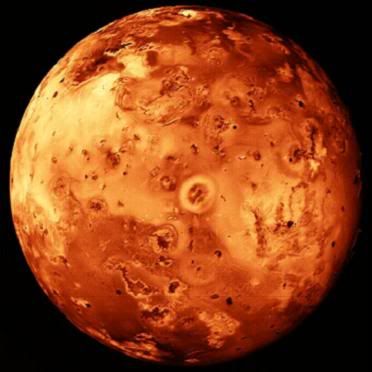
Volcanic activity on the Jupiter moon lo
With over 400 active volcanoes, Io is the most geologically active object in the Solar System. This extreme geologic activity is the result of tidal heating from friction generated within Io's interior as it is pulled between Jupiter and the other Galilean satellites -Europa, Ganymede and Callisto. Several volcanoes produce plumes of sulfur and sulfur dioxide that climb as high as 500 km (300 mi) above the surface.
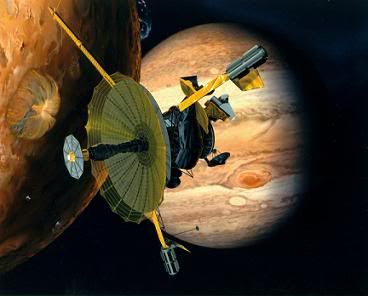
The Galileo space craft at Jupiter and Lo
Io's surface is also dotted with more than 100 mountains that have been uplifted by extensive compression at the base of the moon's silicate crust. Some of these peaks are taller than Earth's Mount Everest. Unlike most satellites in the outer Solar System, which are mostly composed of water ice, Io is primarily composed of silicate rock surrounding a molten iron or iron sulfide core. Most of Io's surface is characterized by extensive plains coated with sulfur and sulfur dioxide frost.
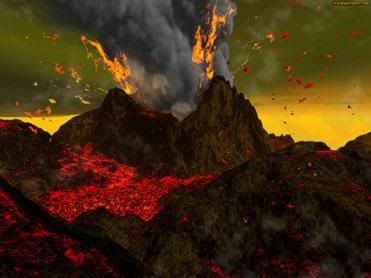
Volcanic activity on lo-An artist's rendering
Io's volcanism is responsible for many of the satellite's unique features. Its volcanic plumes and lava flows produce large surface changes and paint the surface in various shades of yellow, red, white, black, and green, largely due to allotropes and compounds of sulfur. Numerous extensive lava flows, several more than 500 km (300 mi) in length, also mark the surface. The materials produced by this volcanism provide material for Io's thin, patchy atmosphere and Jupiter's extensive magnetosphere. Io's volcanic ejecta also produce a large plasma torus around Jupiter.
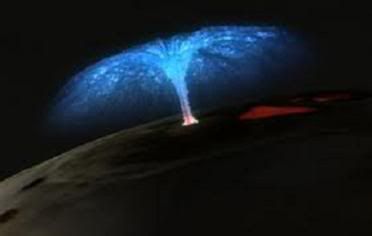
A volcanic plume on lo
Io played a significant role in the development of astronomy in the 17th and 18th centuries. It was discovered in 1610 by Galileo Galilei, along with the other Galilean satellites, and the discovery furthered the adoption of the Copernican model of the Solar System
To see video of Lo just click on the link below. Has sound
www.youtube.com/watch?v=KXeIll6YYQs
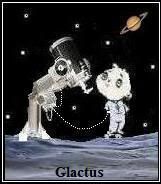
Credits: These are NASA/JPL images
Text by Wikipedia
Video by YouTube

Volcanic activity on the Jupiter moon lo
With over 400 active volcanoes, Io is the most geologically active object in the Solar System. This extreme geologic activity is the result of tidal heating from friction generated within Io's interior as it is pulled between Jupiter and the other Galilean satellites -Europa, Ganymede and Callisto. Several volcanoes produce plumes of sulfur and sulfur dioxide that climb as high as 500 km (300 mi) above the surface.

The Galileo space craft at Jupiter and Lo
Io's surface is also dotted with more than 100 mountains that have been uplifted by extensive compression at the base of the moon's silicate crust. Some of these peaks are taller than Earth's Mount Everest. Unlike most satellites in the outer Solar System, which are mostly composed of water ice, Io is primarily composed of silicate rock surrounding a molten iron or iron sulfide core. Most of Io's surface is characterized by extensive plains coated with sulfur and sulfur dioxide frost.

Volcanic activity on lo-An artist's rendering
Io's volcanism is responsible for many of the satellite's unique features. Its volcanic plumes and lava flows produce large surface changes and paint the surface in various shades of yellow, red, white, black, and green, largely due to allotropes and compounds of sulfur. Numerous extensive lava flows, several more than 500 km (300 mi) in length, also mark the surface. The materials produced by this volcanism provide material for Io's thin, patchy atmosphere and Jupiter's extensive magnetosphere. Io's volcanic ejecta also produce a large plasma torus around Jupiter.

A volcanic plume on lo
Io played a significant role in the development of astronomy in the 17th and 18th centuries. It was discovered in 1610 by Galileo Galilei, along with the other Galilean satellites, and the discovery furthered the adoption of the Copernican model of the Solar System
To see video of Lo just click on the link below. Has sound
www.youtube.com/watch?v=KXeIll6YYQs
Credits: These are NASA/JPL images
Text by Wikipedia
Video by YouTube


